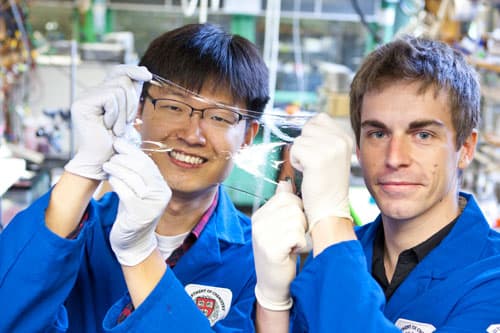Harvard University Researchers Build Transparent Gel-Based Audio Speaker
Postdoctoral fellows Jeong-Yun Sun and Christoph Keplinger of Harvard School of Engineering and Applied Sciences (SEAS) have developed a gel-based transparent stretchable speaker that can produce sounds from the entire audible spectrum of 20Hz to 20 KHz. The main component of the speaker is a thin sheet of rubber that has been sandwiched between two layers of clear saltwater gel. When a high voltage signal is passed through the speaker it forces the rubber to rapidly contract and these vibrations produce the sounds. Have a look at the video below, where the transparent speaker has been connected with a regular laptop and is playing “Morning†prelude by Peer Gynt.
The main purpose of this experiment was to show the feasibility of ionic conductors. In ionic conductors electrical charges are carried by the ions instead of electrons and since ions are free to move around the conductor, it can be stretched without affecting its resistivity. Previously, ionic conductors used to break down due to unwanted chemical reactions caused by high voltage. To take care of this problem, the researchers from Harvard used the rubber as an insulator which effectively controls the voltage and prevents the harmful chemical reactions. The researchers are hopeful that this ionic conductor will be used to make flexible electronic devices and since they are transparent they will surely optical applications as well. The researchers also state that these ionic devices can be incorporated into biological systems like artificial muscles and skins because the gels used as electrolytes are biocompatible.

Source: #-Link-Snipped-#
The main purpose of this experiment was to show the feasibility of ionic conductors. In ionic conductors electrical charges are carried by the ions instead of electrons and since ions are free to move around the conductor, it can be stretched without affecting its resistivity. Previously, ionic conductors used to break down due to unwanted chemical reactions caused by high voltage. To take care of this problem, the researchers from Harvard used the rubber as an insulator which effectively controls the voltage and prevents the harmful chemical reactions. The researchers are hopeful that this ionic conductor will be used to make flexible electronic devices and since they are transparent they will surely optical applications as well. The researchers also state that these ionic devices can be incorporated into biological systems like artificial muscles and skins because the gels used as electrolytes are biocompatible.

Source: #-Link-Snipped-#
0
